![]()
![]()
![]()
Use LEFT and RIGHT arrow keys to navigate between flashcards;
Use UP and DOWN arrow keys to flip the card;
H to show hint;
A reads text to speech;
77 Cards in this Set
- Front
- Back
|
what are the six factors that influence maintenance of parasitic life?
|
identification of an appropriate host
establishment of a productive infection (access to appropriate tissue/cell type) mechanisms to establish an appropriate niche within the host mechanisms to minimize innate and acquired immune responses establish a balance between reproduction rate to maintain host viability and potential to spread to a new host. |
|
|
what group are single celled eukaryotes grouped into?
|
Protozoa (not fungi - mycology)
|
|
|
what group are multicellular eukaryotes grouped into? What all is included in this grouping?
|
Metazoa: helminths (worms), arthropods (insects, arachnids, crustacea, mites), and Molluscs (snails)
|
|
|
T/F
Many arthropods and some molluscs cause disease directly. |
FALSE
Many arthropods and some molluscs do NOT directly cause diseas but act as vectors or resevoirs for both protozoan and helminth parasites. |
|
|
how are protozoans classified?
|
based on basis of mode of reproduction and locomotive organelles.
|
|
|
what three classes in the classification of protozoa reproduce via binary fission? which one doesn't?
|
rhizopods, ciliates, flagellates.
Soprozoa reproduces via schizogony/sporogony. |
|
|
what are the four classes of protozoa?
|
rhizopods, ciliates, flagellates, and soprozoa.
|
|
|
which class of protozoa uses pseudopods as its organelle of locomotion?
|
Rhizopods
|
|
|
which class of protozoa uses cilia as its organelle of locomotion?
|
Ciliates
|
|
|
which class of protozoa uses flagella as its organelle of locomotion?
|
Flagellates
|
|
|
which class of protozoa has no organelle for locomotion?
|
soprozoa
|
|
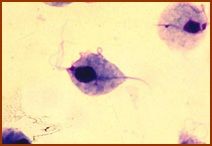
Name the class of Protozoa.
|
Flagellates
|
|
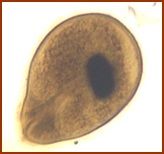
Name the class of protozoas.
|
Ciliates
|
|
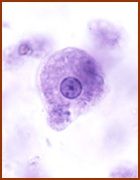
Name the class of protozoas.
|
Rhizopods
|
|
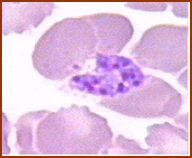
Name the class of protozoas.
|
Sporozoa
|
|
|
what does kinetoplastid refer to?
|
an order of flagellate protozoa with special characteristics
|
|
|
what are the characteristics of a kinetoplastid?
|
the presence of 1 or 2 flagella arising form a depression in the cell body
a single mitochondrion that extends the length of the body. |
|
|
What are the three examples given of kinetoplastids?
|
trypoansoma brucei (sleeping sickness)
Trypanosoma cruzi (chagas disease) Leishmania (Leishmaniasis) |
|
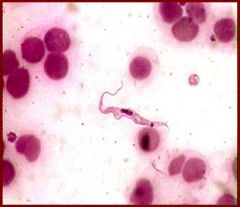
What is the grouping and order of this organism?
|
group: Flagellates
order: kinetoplastids |
|
|
what are the three types of binary fission?
|
longitudinal, binary, and transverse
|
|
|
how is sexual reproduction of the protozoan parasite mediated?
|
by fusion of gametes followed by chromosomal recombination.
|
|
|
How are the helminths classified?
|
done on the basis of body and alimentary tract configuration, nature of the reproductive system, number of intermediate hosts required to complete the life cycle.
|
|
|
what are the three classes of helminths?
|
nematode (roundworm), cestode (tapeworm), and Trematode (fluke)
|
|
|
which two members of the helminths category have a hermaphroditic sex?
|
cestode (tapeworm) and Trematode (fluke)
|
|
|
what is the morphology of the nematode?
|
spindle shaped
|
|
|
what is the morphology of the cestode?
|
head with segmented body
|
|
|
what is the morphology of the trematode?
|
leaf shaped with oral and ventral suckers
|
|
|
what does the alimentary tract look like in a nematode?
|
tubular
|
|
|
what does the alimentary tract look like in a cestode?
|
none
|
|
|
what does the alimentary tract look like in a trematode?
|
blind
|
|
|
which member of the helminth group requires one intermediate host? two? variable?
|
cestode, trematode, and nematode (in that order)
|
|
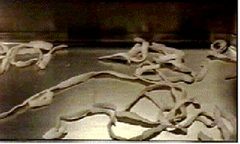
Name this member of the helminths group.
|
Cestode
|
|
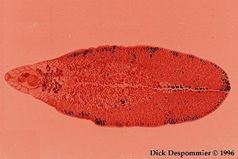
Name this member of the helminths group.
|
Trematode
|
|

Name this member of the helminths group.
|
Nematode
|
|
|
what are the six arthropod parasites that are listed as vectors of parasitic diseases?
|
mosquito, tsetse fly, riduviid bug, phlebotomous sandfly, crysops fly, and tick
|
|
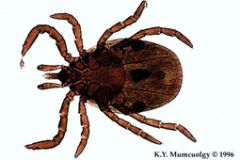
Name the arthropod and associated parasitic disease(s).
|
tick; Babesiosis
|
|
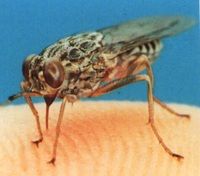
Name the arthropod and associated parasitic disease(s).
|
Tsetse fly; Trypanosomiasis
|
|
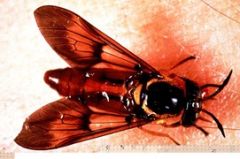
Name the arthropod and associated parasitic disease(s).
|
Crysops fly; Loa Loa
|
|
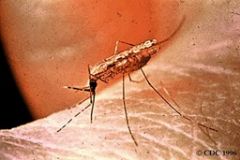
Name the arthropod and associated parasitic disease(s).
|
Mosquito; malaria, filaria
|
|
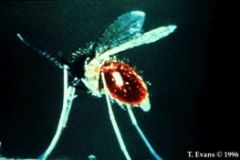
Name the arthropod and associated parasitic disease(s).
|
Phlebotomous sandfly; Leishmaniasis
|
|
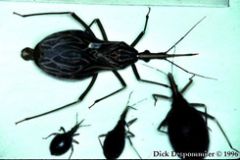
Name the arthropod and associated parasitic disease(s).
|
Riduviid Bug; Chagas Disease
|
|
|
what is a host?
|
a host is an animal on or within which a parasite can establish an infection.
|
|
|
what are the two different types of hosts?
|
definitive and intermediate
|
|
|
which type of host has a parasite pass its adult phase or sexual reproductive phase of its life cycle within the host? Give an example
|
definitive; Trichomonas Vaginalis
|
|
|
which type of host has a parasite pass through its larval or asexual phase of its life cycle within the host? Give an example
|
intermediate; plasmodium
|
|
|
Transmission to which host will allow for higher levels of parasite in the population?
|
intermediate host
|
|
|
Transmission to which host will allow for sexual recombination and diversity'?
|
definitive host
|
|
|
what mechanism do parasites have that allow them to survive in the environment in the absence of an appropriate host'?
|
cyst forms
|
|
|
How do parasites survive when the conditions are not right for transmission?
|
by maintaining a dormant state within a host.
|
|
|
T/F
Parasites can be directly transmitted from one Vertebrate to another. |
TRUE!
|
|
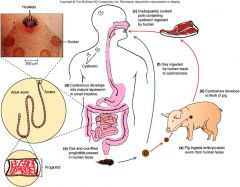
describe the representative life cycle of a parasitic helminth.
|
Pig ingests embryonated ovum from human feces, cysticercus develops in flesh of pig, inadequately cooked pork containing cysticerci ingested by human, cysticercus develops into mature tapeworm in small intestine, and ova and ova-filled proglottids passed human feces.
|
|
|
what are the four general stages of the parasitic helminth lifecycle?
|
egg--> larval stages --> mature worm --> mating
|
|
|
T/F
Parasitic infections tend to be acute and short term. |
FALSE:
chronic and long term |
|
|
how does the parasite ensure long term residence in the host?
|
by either avoiding, modulating or subverting the immune system.
|
|
|
T/F
Manipulation of the immune response via the parasite on the host, should be global as in infection with the "acute" pathogens with the aim of killing the host. |
FALSE:
The parasites do NOT want to kill the host, because that is their home. lol There is no place like home. |
|
|
Self Pity
Care Nurturing Mother Attention Self Awareness |
Muriaticum
|
|
|
will the ideal parasite affect the "fitness" of the host?
|
no
|
|
|
What is a granuloma formation?
|
how the host's body sequesters the pathogen.
|
|
|
what are stages of parasite infections defined by (3)?
|
Incubation, prepatent and patent period.
|
|
|
what is the time from the acquisition of infection to the appearance of symptoms called?
|
incubation period
|
|
|
what is the period between infection with a parasite and the demonstration of the parasite in the body called?
|
prepatent period
|
|
|
what determines the prepatent period?
|
the recovery of an infective form from the blood or feces
|
|
|
what is the period of time in the course of a parasitic disease during which the parasitic organisms can be demonstrated in the body?
|
patent period
|
|
|
what two periods can range from days to years, but will not become apparent in hours?
|
prepatent and patent period
|
|
|
what two parasites are members of the 10 biggest killers?
|
roundworm/hookworm and malaria
|
|
|
what are the six factors affecting the spread and prevalence of parasitic diseases?
|
poor sanitation conditions
failure of sanitation measures contact with symptomatic and asymptomatic carriers animal to human transmission presence of an appropriate vector long incubation/latency periods of certain parasitic infections. |
|
|
what are "other" factors that will affect the spread and prevalence of parasitic diseases?
|
global travel (air), immune suppression (HIV-AIDS), institutionalized populations, migration/immigration, war/civil unrest, famine and behavioral aspects.
|
|
|
what is a salient feature of helminth infection that is not always helpful?
|
eosinophilia
|
|
|
what is the cornerstone of diagnosis of parasitic infection?
|
identification of the parasite in the stool, urine, sputum, blood, and tissue.
|
|
|
What type of protozoa can we find in sputum?
|
flukes and some helminth
|
|
|
what do the serologic tests detect?
|
Antibodies and antigens
|
|
|
where are antibodies detected? antigens?
|
antibodies - serum; antibodies - blood, tissues and body fluids
|
|
|
P.falciparum, T.cruzi, T. brucei, Oncocerca spp. and agents of lymphatic require this technique to be diagnosed.
|
Molecular biology via DNA probes.
|
|
|
what do antiprotozoan drugs interfere with?
|
nucleic acid synthesis or with carbohydrate metabolism
|
|
|
what is compromised with antihelminthic drugs?
|
the worm's glycolytic pathways or neuromuscular function
|
|
|
T/F
in most cases, host and parasite have comparable target site for chemotherapeutics. |
true :)
|
|
|
how is differential toxicity achieved between the target site of the host and parasite?
|
via preferential uptake, metabolic alteration of the drug by the parasite, and differential susceptibility of the comparable sites in parasite and host.
|

